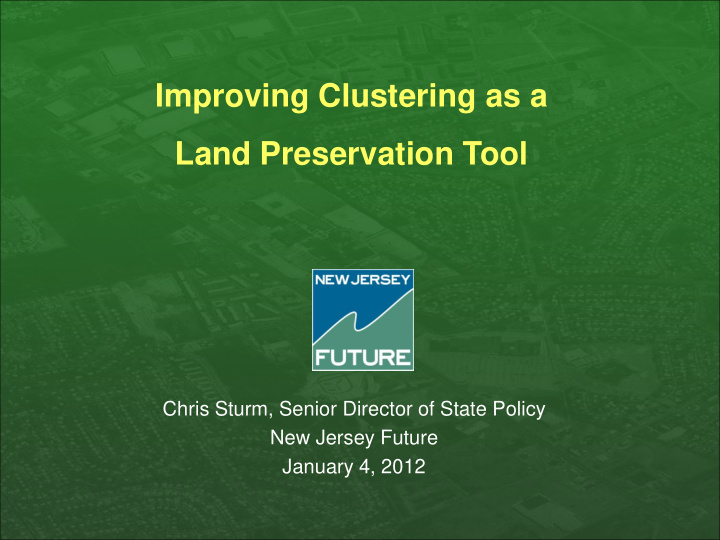



Improving Clustering as a Land Preservation Tool Chris Sturm, Senior Director of State Policy New Jersey Future January 4, 2012
Smart Growth research, policy and advocacy organization Development that protects open space and farmland, strengthens communities, keeps housing affordable, provides transportation choices and fuels a prosperous economy
Threats to Preserving Farmland and Supporting Agriculture • State and local governments can’t afford to buy all the land that needs protecting • Haphazard development fragments contiguous farmland, exacerbating conflicts with neighbors
Farmland in1986 Changing Landscapes in the Garden State, Rowan & Rutgers Universities, 2010
1995
2002
2007
2007, with Loss Shown in Red
Focusing on a sample area
If we could go back in time… what planning tools could have been used? Large lot zoning Lot size averaging Clustering Noncontiguous clustering Transfer of Development Rights (TDR) Franklin Township, NJ. Google maps 2011
Large Lot Zoning Lot sizes are increased to reduce the amount of development on a parcel Franklin Township, NJ., Google maps 2011. (Parcel boundaries are fictitious)
Lot Size Averaging The number of units stays the same, but the developer can shrink some lots and make others bigger. Franklin Township, NJ., Google maps 2011. (Parcel boundaries are fictitious)
Contiguous Clustering Development is concentrated on a portion of the site, and the rest is preserved as open space Franklin Township, NJ., Google maps 2011. (Parcel boundaries are fictitious)
Contiguous Clustering In this example, development is concentrated on the perimeter of the site, and a small farm is preserved. Slide courtesy of Clarke Caton Hintz
Noncontiguous Clustering Municipality designates multiple parcels that a developer may choose from and treat as a single cluster even if they are noncontiguous Franklin Township, NJ., Google maps 2011. (Parcel boundaries are fictitious)
Noncontiguous Clustering A developer may cluster units from one parcel onto another parcel, which would be developed more intensely. Franklin Township, NJ., Google maps 2011. (Parcel boundaries are fictitious)
Noncontiguous Clustering A developer may cluster units from multiple parcels onto another parcel, which is developed more intensely. Franklin Township, NJ., Google maps 2011. (Parcel boundaries are fictitious)
Noncontiguous Clustering Basics • Authorized by Municipal Land Use Law (MLUL) MLUL allows town to create a “planned development” • zone on multiple noncontiguous properties that can be developed as a single cluster: • “Sending area” parcel(s) are preserved • “Receiving area” parcel(s) are developed more intensively to accommodate the extra units • Voluntary: requires a “deal” between the municipality, sending area landowner(s), and receiving area landowner/developer
Plainsboro example Noncontiguous cluster helped create 1,025- acre Plainsboro Preserve. 100 acres near the lake were preserved. 30 units were built on another property. A single person owned both properties and made an agreement with a developer.
Hillsborough example Noncontiguous clustering used on five parcels for Hillsborough Chase project 105 homes recently constructed by Toll Brothers 157 acres on four parcels were permanently preserved and given to the township.
Other New Jersey Examples • Monroe Township, Middlesex County • Robbinsville, Mercer County • North Hanover Township, Burlington County • Hopewell Township, Mercer County • Ocean Township, Ocean County • Middle Township, Cape May County
Transfer of Development Rights Used on a larger scale Planned Developers may build Village more units in the designated growth area, if they purchase development rights from landowners in the preservation area Chesterfield Township, NJ., Courtesy Clarke, Caton, Hintz.
Comparing the Tools Large lot • Affordable: zoning preserves land with private funds Lot size • Simple: Relatively averaging easy to use • Fair: Protects Clustering landowner equity Noncontiguous • Needs improved clustering statutory authority TDR
Proposed MLUL Amendments -- for All Cluster Tools . Permissive Authorizes establishment of maximum lot sizes, FAR Authorizes clustering of residential and/or non- residential uses Authorizes clustering to preserve not only open space, but also farmland and historic sites Requires permanent preservation through easement Explicitly authorizes mandatory contiguous clustering (already in use) Explicitly authorizes lot-size averaging (already in use)
Noncontiguous Cluster – Special Issues • More powerful, larger-scale tool • Voluntary and market-driven – Town may have to serve as a broker for landowners and developer • Incentives, such as bonus units and infrastructure, may be helpful. • Legal constraints: • Courts have thrown out noncontiguous ordinances if they “seem like” TDR
Proposed MLUL Amendments – for Noncontiguous Clustering . Keeps noncontiguous voluntary on part of landowners Simplifies municipal planning obligations: Doesn’t require creation of a “Planned Development” Expands powers while distinguishing from TDR Authorizes towns to establish criteria for -- or designate -- areas for growth and areas for preservation Does not allow towns to access TDR provisions Allows same or greater development potential than provided by underlying zoning Can be increased to maintain equity or to create an incentive for developers to participate
Encouraging More “Livable Places and Open Spaces” . The proposed MLUL amendments should lead to greater use of clustering: Clarifies municipal authority for existing practices Clarifies when noncontiguous clustering may be used, without having to meet the requirements for TDR Provides towns greater ability to control where and how growth and preservation would occur Gives property owners another option for developing their property, one that may better meet market demand. Applicable in rural, suburban and urban settings
www.njfuture.org Chris Sturm 609-393-0008, x114 csturm@njfuture.org
Recommend
More recommend